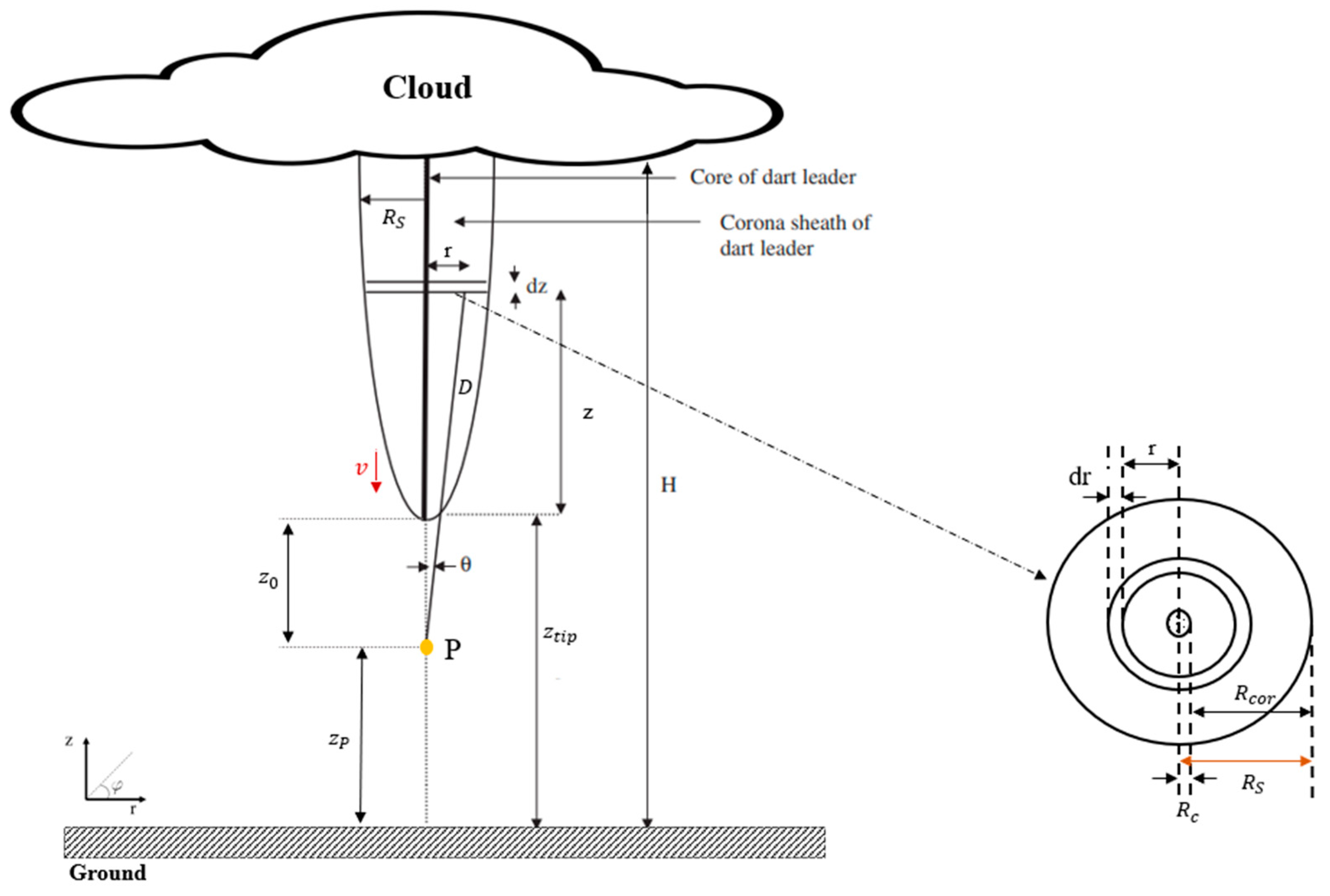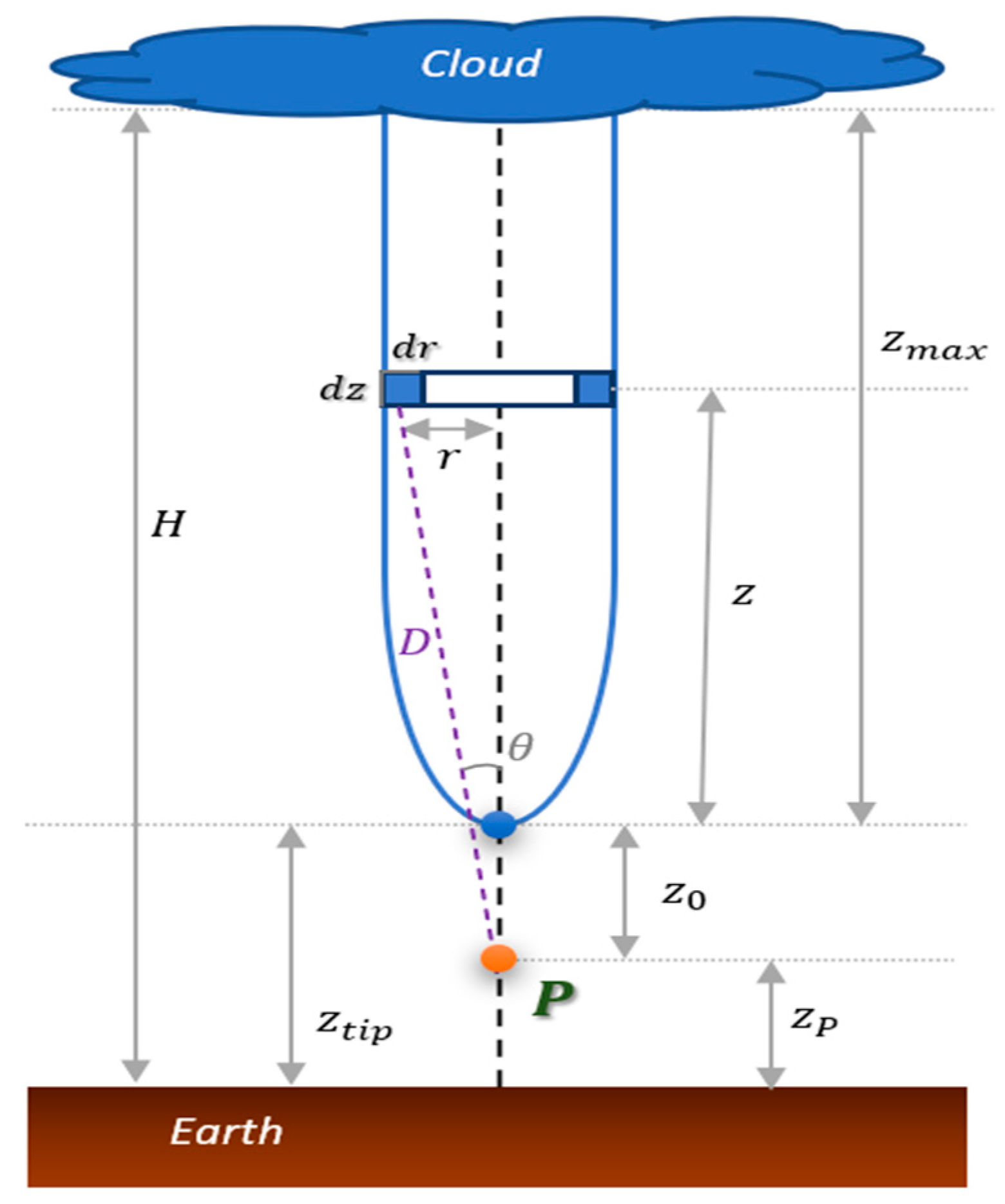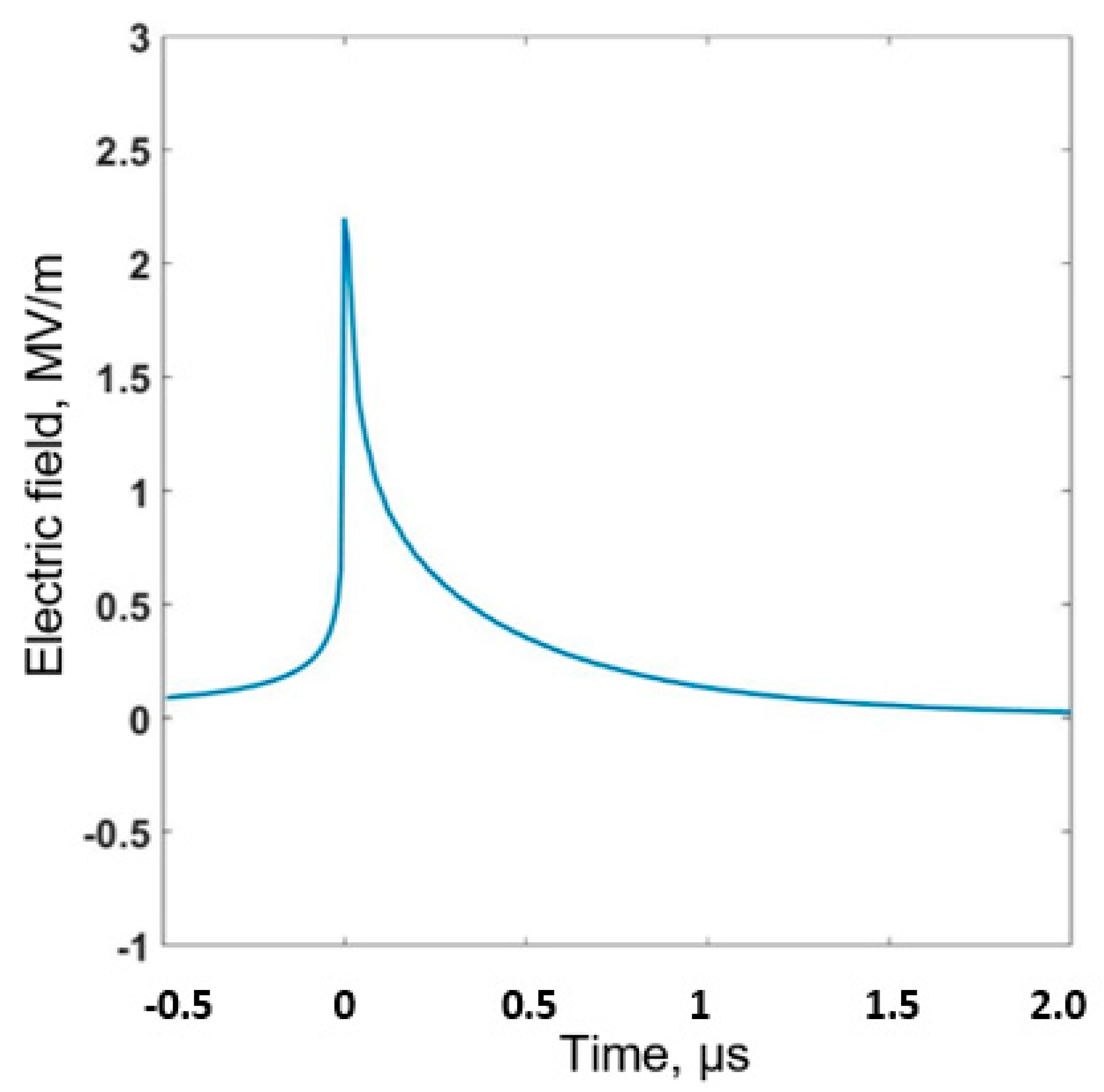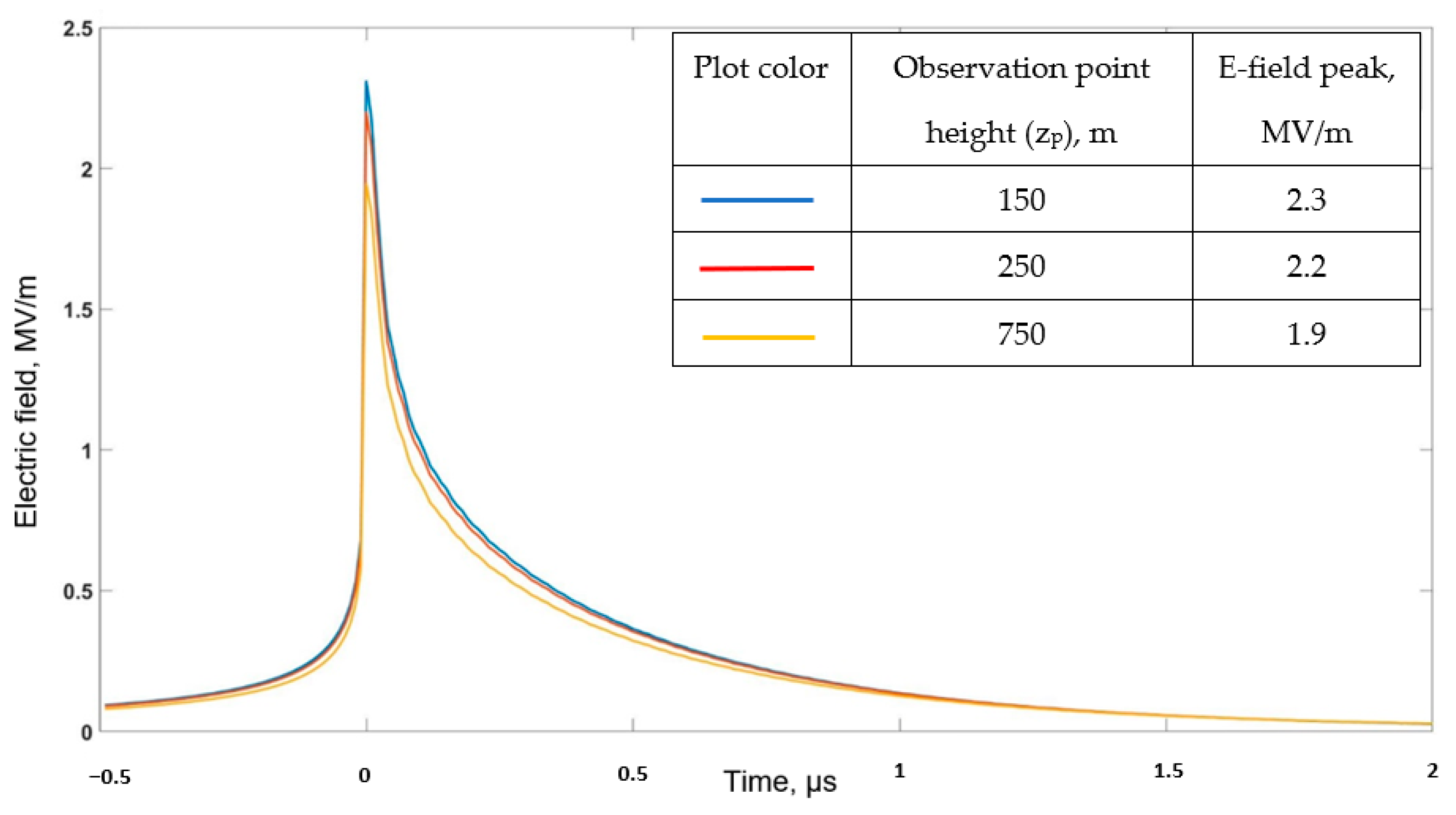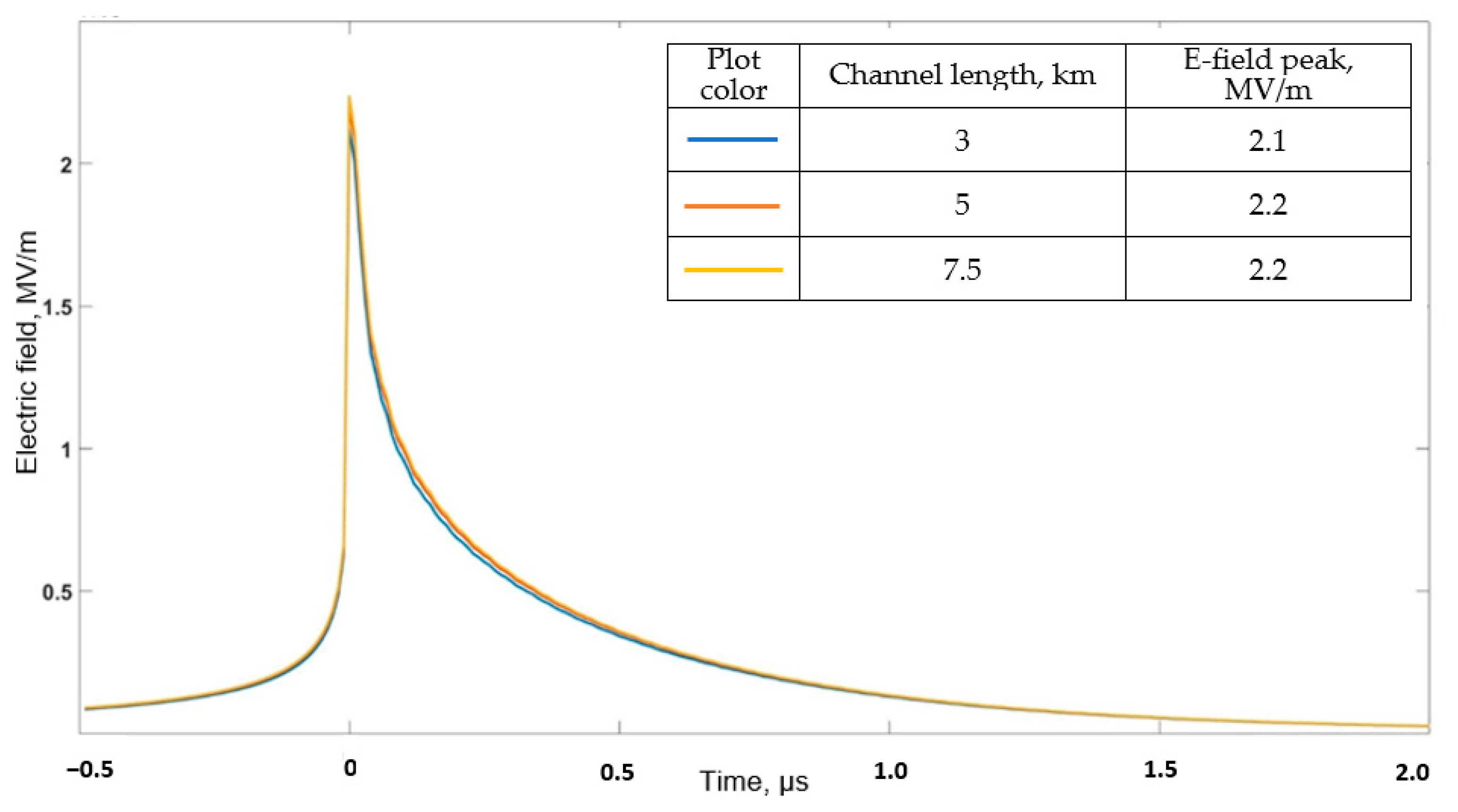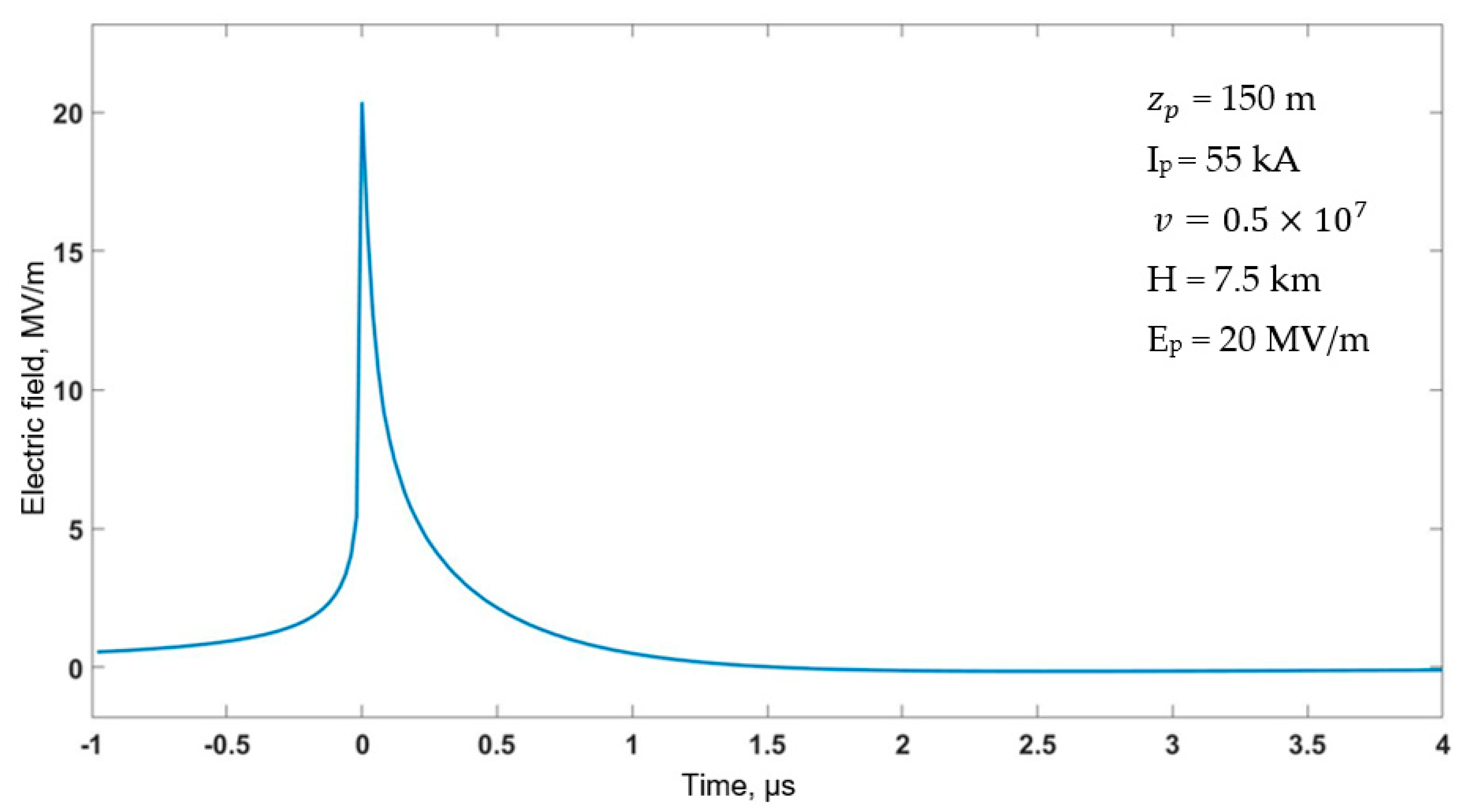1. Introduction
X-rays/gamma-rays (in lightning research, the boundary between the two is usually placed at 1 MeV) are produced by all types of downward lightning leaders when they are typically within 100 m or so of the ground (Dwyer (2004) [
1], Mallick et al. (2012) [
2]). Lightning leaders emit X-rays/gamma-rays when the electric field and channel properties are such that free electrons can run away; that is, they gain more energy from the electric field than they lose by collisions with air molecules. The emission occurs when runaway electrons experience deflection by the electric field of other charged particles (typically atomic nuclei), a process that is referred to as Bremsstrahlung or braking radiation.
The rate of electron energy loss per unit distance is often called the friction force and its dependence on electron energy is represented by the so-called friction curve. Two such curves, for cold air and for air at 3000 K, are shown in
Figure 1.
Table 1 compares the various scenarios of acceleration and multiplication of runaway electrons in terms of the source of seed electrons, air temperature, and characteristic electric field. Conventional (non-relativistic) avalanches are additionally included as a reference. In
Table 1, the ambient electron-energy distribution includes electrons with energies less than 30 eV or so, while the so-called cosmic-ray secondaries (electrons produced by very high energy (10
15–10
16 eV or greater) cosmic-ray particles) have energies exceeding 0.1–1 MeV. For comparison, the average energy of electrons in conventional electric breakdown is just a few electron-volts. It follows from
Table 1 that there are three main factors that can serve to initiate and sustain the multiplication of runaway electrons: (1) super-high electric field, (2) energetic electrons supplied by external sources, and (3) elevated air temperature (reduced air density).
Subsequent leaders discussed here traverse still warm (3000 K) remnants of previously created but decayed channels (e.g., Rakov and Uman 2003 [
4], Table 4.9), which corresponds to the second to last row of
Table 1. At the same pressure (a reasonable assumption for lightning channels), an order of magnitude elevated temperature means an order of magnitude lower air density (Uman and Voshall, 1968 [
5],). For such warm channels, the critical runaway breakdown field is considerably (about an order of magnitude) lower than in cold air. In this paper, we calculate the electric fields expected to exist at the tip of a subsequent leader; they will be used for computing Coulomb’s force, which, in turn, will be compared to the friction force for warm air, as per the 3000 K friction curve shown in
Figure 1. We also examine the dependence of electric field peak on the leader model input parameters, including the prospective return-stroke peak current (a proxy for the leader tip potential) and leader propagation speed, and compare model predictions with measurements.
2. Leader Model Description
The model presented by us is meant to apply to any subsequent (dart, dart-stepped, or chaotic) leader developing in a warm (reduced air density) channel, although the stepping process is not included in the model. Only the charges deposited on the leader channel (mostly in the corona sheath) are considered in computing electric fields. We assume that the leader path is straight and vertical, and we place the observation point (the point where the electric field is computed) on this path, with the leader tip approaching the point, traversing it, and moving beyond that point.
Dwyer et al. (2012, 2012) [
6,
7] experimentally showed that lightning leader tips are primarily responsible for X-ray emissions; thus, special attention has been paid to the electric field calculations near the leader tip. In all the electric field equations presented in this paper,
corresponds to the time at which the leader tip passes the observation point. The leader model described below follows the ideas forming the basis of the model proposed by Cooray et al. (2009, 2010) [
8,
9].
We consider the leader propagating downward at a constant speed along the vertical channel that was created by the preceding return stroke, decayed, but is still warm.
The travelling current source model used here is similar to the ones previously described by Cooray et al. (2009, 2010) [
8,
9], Bazelyan (1995) [
10], and Thottappillil et al. (1997) [
11]. It employs an approach in which the leader tip acts as downward moving current source launching a current wave moving upward, with the associated positive charge leaking radially outward to form the leader corona sheath. Each segment of the leader channel injects radial streamer current charging the corona sheath, the radius of which increases with height (see
Figure 2). This is different from the distributed-source return-stroke models Maslowski et al. (2007) [
12] where the distributed current sources (modeling the corona sheath charged during the leader stage) are progressively tapped by the upward-moving return-stroke front.
In Cooray et al. (2009) [
8] and Cooray et al. (2010) [
9], the dipole approximation was used in the field calculations and this had limited the numerical accuracy of the calculation. In the present work, the monopole approximation was used. According to this formulation, the electric field at any given point along the channel can be divided into static field produced by stationary charges, velocity field generated by moving charges and radiation field produced by accelerating charges (See Cooray et al. (2010) [
13]). The results obtained show that the tip electric field is mainly determined by the static field term alone, while the contributions from the velocity and radiation fields can be neglected. For this reason, only the static field term is used in the calculations.
Furthermore, contributions from the charges inside the cloud are assumed to be insignificant in the present study. The presence of ground is also neglected.
We computed the electric field due to the leader charges at different points along its axis, both ahead and behind the leader tip. In other words, the longitudinal electric fields were computed at any point (see point P in
Figure 2) along the leader axis aligned with the
z-axis (directed upward with
z = 0 at the ground level) of the cylindrical coordinate system. We assumed that at time
, the tip of the leader is located at height
above the ground. We introduce the equations for the static component of the electric field in
Section 3.
In order to compute the electric field produced by the dart leader channel, first, we have to establish the leader channel geometry and the electric charge distribution along the channel during the leader propagation toward the ground. The maximum leader charge per unit length (
—maximum line charge density) at height
of the leader channel can be related to the prospective return-stroke current peak
. Cooray et al. (2007) [
14] have shown that the maximum line charge density
for
can be expressed based on the following empirical formula:
where
is the cloud charge source height in
,
and
are in
, and
is the return-stroke peak current in
. The other symbols represent empirical constants or functions determined in Cooray et al. (2007) [
14] and given below:
Leader channel consists of a narrow hot core of radius
and a radial corona sheath of thickness
(see inset in
Figure 2) with
increasing with time. Based on Gauss’s Law, the maximum thickness of corona sheath at height
,
, can be found using the line charge density,
, the breakdown electric field, (assumed to be
), and the electric permittivity of air,
, as follows:
Assuming that the charge at
exponentially increases from 0 to
with time constant
(See Cooray et al. (2010) [
9]), we express the line charge density at height
seen at the observation point
(see
Figure 2) as:
where
is the retarded time required for the electric field to propagate from the source element
to the observation point
when the downward-moving leader tip has arrived at height
. The retarded time,
, can be computed as:
where
is the downward leader speed and
is the speed of light (
).
The total radius of the leader channel,
(see inset in
Figure 2), at height
increases from
(assumed to be equal to
according to Cooray (1996) [
15]) to
, computed using Equation (5). Following Cooray et al. (2010) [
9], we assumed that the expansion of corona sheath is exponential and the total leader channel radius is given by:
where
is the retarded time computed using Equation (7), 2.3 is an empirical constant determined in Cooray et al. (2010) [
9], and
is time during which the corona sheath attains its maximum extent at height
, estimated as:
with
being the speed of the streamers forming the corona sheath, which was set to
, according to Cooray (2014) [
16].
The volume charge density,
in
, in the leader channel (including both the core and the corona sheath), assumed to be independent of the radial distance r from the leader axis, can be found as:
where
is the retarded time computed using Equation (7).
3. Electric Field Equations
To compute the electric field produced by the leader channel, we must account for two different situations: (1) when the observation point P is in front of (below) the leader tip (between ground and the leader tip, see
Figure 3) and (2) when the observation point P is behind (above) the leader tip (between the leader tip and the cloud, see
Figure 4). In both cases, it is assumed that the observation point P is on the vertical axis of the lightning leader channel (see
Figure 2). Therefore, the electric field produced at observation point P will only have a component along the
z-axis.
Due to cylindrical symmetry of the problem, it is convenient to consider an elementary ring with radius r and square cross-sectional area
, so that the ring volume is
, placed at height z above the leader tip (see
Figure 2). For this ring, the static electric field at observation point P will be:
where
is the inclined distance between each of the points on the ring and the observation point
(a function of
,
, and
, see
Figure 2;
is the angle shown in
Figure 2 dependent on
,
,
and
;
is the volume of the elementary ring, and
is given by (7).
Thus, (11) can be written as:
The total static electric field at observation point is found by integrating over r and z, with integration over azimuth being already accounted for by using the ring geometry.
3.1. Case 1: Point P Is in Front of the Leader Tip
In this case, the leader tip has not yet reached the observation point
. The entire leader channel is above the observation point (see
Figure 3), which allows us to treat the problem using a single equation, with
,
, and the retarded time
given by:
The total static electric field produced by the entire leader channel at observation point
is found using the following double integral equation:
where
is the maximum value of
, which is the difference between
and
.
Evaluating the integral over r from 0 to
, for given
and
, we obtained:
3.2. Case 2: Point P Is behind the Leader Tip
In this case, the leader tip has passed the observation point P, so that part of the leader channel is above the observation point (see
Figure 4a) and part of the channel is below the observation point (see
Figure 4b).
The electric field component produced by the leader charges above the observation point
can be computed in a way similar to that presented in
Section 3.1 for Case 1. The leader charges below the observation point will produce an electric field component with opposite direction, so that the total electric field produced by the entire leader channel at observation point
can be expressed as:
where
is the electric field due to the leader charges at or above the observation point and
is the electric field due to the charges below the observation point.
For the leader channel at or above the observation point
, (
) we can write (see
Figure 4a):
For the leader channel below the observation point
(
), we have (see
Figure 4b):
As a result,
is given by:
The total electrostatic field for Case 2 is obtained by algebraically adding the contributions given by (18) and (20), as per Equation (16).
5. Discussion and Implications for X-ray/Gamma-ray Production by Subsequent-Stroke Leaders
As noted in the Introduction, subsequent leaders discussed in this paper traverse warm (reduced air density) channels. For such channels, the critical runaway breakdown field is considerably (about an order of magnitude) lower than in cold air. We calculated the electric fields expected to exist at the tip of a subsequent leader, which were used for computing the Coulomb force, which, in turn, was compared to the friction force for warm air, as per the 3000 K friction curve shown in
Figure 1. We also examined the dependence of electric field peak on the leader model input parameters, including the prospective return-stroke peak current (a proxy for the leader tip potential) and leader propagation speed.
Based on the sensitivity analysis presented in
Section 4.2 above, we found the “worst case” combination of model input parameters, such that the electric field peak is maximized:
150 m,
55 kA,
H = 7.5 km, and
For these values, the electric field peak predicted by our model is 20 MV/m (see
Figure 10). The Coulomb force acting on an electron corresponding to a field of 20 MV/m is considerably larger than the peak of the friction curve for warm air (~4 MV/m; see red curve in
Figure 1) allowing all electrons (regardless of their energy) to run away. This means that a relativistic runaway process does not require the presence of a super-energetic cosmic-ray particle and can start from the ambient electron distribution. The event presented in
Figure 10 can be viewed as representing the very intense X-ray/gamma-ray producer reported by Mallick et al. (2012) ([
2], Figure 7, bottom panel). That stroke followed the previously formed (warm) channel to ground and had the NLDN-reported peak current of 55 kA and the leader speed, inferred from the measured leader duration and assumed total channel length of 7.5 km, of
, values similar to those used in computing the E-field waveform shown in
Figure 10.
The present study provides additional support to the elevated-temperature scenario (previously considered by Mallick et al. (2012) [
2] and Tran et al. (2015, 2019) [
3,
17]), which requires realistic (confirmed by modeling) electric fields and no energetic electrons from external sources. Furthermore, we have shown that subsequent-leader electric fields can be high enough to overcome the warm-air friction curve, but not strong enough to overcome the cold-air friction curve, the latter one being applicable to first-stroke leaders. This implies that in, say, a two-stroke flash with both strokes having the same intensity, the second stroke may be producing X-rays/gamma-rays, while the first stroke may not.
6. Summary and Concluding Remarks
A new formulation of the model for computing E-fields both ahead and behind of the downward moving leader tip was developed. The electric field waveform on the axis of vertically descending leader is a sharp pulse with its peak corresponding to the leader tip passing through the observation point.
Dependence of the E-field peak on model input parameters was examined. The E-field peak increases with increasing the prospective return-stroke peak current (a proxy for leader tip potential) and with decreasing the leader speed. This is an interesting finding, as generally, higher peak-current strokes tend to have faster leaders; thus, high peak-current strokes with slow leaders may be uncommon, but they are expected to be prolific X-ray/gamma-ray producers.
For a free electron to run away, the Coulomb force acting on that electron must be greater than the friction force (rate of electron energy loss per unit distance), the latter being a function of electron energy. In this study, we computed subsequent-leader electric fields to see if their associated Coulomb forces can overcome the warm-air friction force acting on ambient electrons with energies less than 30 eV or so. We found that for realistic model input parameters, the E-field peak can exceed the value (~4 MV/m) required for ambient electrons to run away in warm channels that are traversed by subsequent lightning leaders.
Mallick et al. (2012) [
2] discovered that subsequent strokes can be more prolific X-ray/gamma-ray producers than first strokes in the same flash. They hypothesized that their unexpected observation could be explained by the fact that subsequent leaders traversed still warm (3000 K) remnants of previously created but decayed channels, for which the friction curve is considerably lower than for cold air. In this paper, we confirmed Mallick et al.’s hypothesis by showing that subsequent-leader electric fields can be high enough to overcome the warm-air friction curve, but not enough to overcome the cold-air friction curve, the latter one being applicable to first-stroke leaders.

